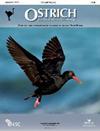热带雨林破碎化对鸟类的影响:以马达加斯加西北部贝马内维卡保护区为例
IF 1.1
4区 生物学
Q2 ORNITHOLOGY
引用次数: 3
摘要
在2016年10月至2018年1月的两个繁殖季节,调查了森林破碎化对马达加斯加西北部Bemanevika保护区(PA)森林鸟类物种的影响。Bemanevika的森林由大片支离破碎的热带雨林组成。调查了7片面积从10公顷到1050公顷不等的森林碎片。使用两种方法沿从森林边缘向森林内部的样带收集数据:雾网和点计数。在所有碎片中,总共记录了27只非森林鸟类和65只森林鸟类。根据其沿边缘-内部梯度的分布,这65种森林物种可分为三大类:15种(23.1%)边缘物种,12种(18.5%)森林内部物种和38种(58.5%)普遍存在物种。较大的森林碎片比较小的森林碎片拥有更多的森林鸟类。在65只森林鸟类中,14只,包括12种森林内部物种,没有在四个较小的碎片(10-29公顷)中发现。森林内部物种密度与森林碎片大小呈正相关。总体趋势是,森林内部物种对森林破碎化最为敏感(例如马达加斯加蛇鹰Eutriochis astur、类Pitta Ground roller Atelornis pittoides和Schlegel的Asity Philepitta schlegeli)。大型猛禽、陆地物种和林下物种是第一个从小碎片中消失的物种。破碎的森林为鸟类提供了栖息地,即使是那些易受森林破碎影响的鸟类,因此,在所有旨在保护森林鸟类的保护战略中,都应考虑保留足够大的森林碎片。本文章由计算机程序翻译,如有差异,请以英文原文为准。
Effects of tropical rainforest fragmentation on bird species: a case study from the Bemanevika Protected Area, northwestern Madagascar
The effects of forest fragmentation on forest bird species in the Bemanevika Protected Area (PA), northwestern Madagascar, were investigated during two breeding seasons from October 2016 to January 2018. The forest of Bemanevika is composed of large patches of fragmented tropical rainforest. Seven forest fragments ranging from 10 to 1 050 ha were surveyed. Two methods were used to collect data along transects orientated from the forest edge toward the interior of the forest: mist-netting and point-counts. In all, 27 non-forest birds and 65 forest birds were recorded at all fragments. According to their distribution along an edge-interior gradient, these 65 forest species are classified into three main groups: 15 (23.1%) edge species, 12 (18.5%) forest interior species and 38 (58.5%) ubiquitous species. Larger forest fragments host more forest bird species than smaller forest fragments. Of the 65 forest birds, 14, including the 12 forest interior species, were not found in the four smaller fragments (10–29 ha). The density of forest interior species was positively correlated to forest fragment size. The general trend was that forest interior species were the most sensitive to forest fragmentation (e.g. Madagascar Serpent-eagle Eutriorchis astur, Pitta-like Ground-roller Atelornis pittoides and Schlegel’s Asity Philepitta schlegeli). Large raptors, terrestrial species and understory species were the first to disappear from the small fragments. Fragmented forests provide habitat for bird species, even for those vulnerable to forest fragmentation, therefore the maintenance of large enough forest fragments should be considered in all conservation strategies aimed to protect forest birds.
求助全文
通过发布文献求助,成功后即可免费获取论文全文。
去求助
来源期刊

Ostrich
生物-鸟类学
CiteScore
2.10
自引率
30.00%
发文量
24
审稿时长
>12 weeks
期刊介绍:
Ostrich: Journal of African Ornithology is the leading ornithological journal in Africa, and publishes peer-reviewed scientific papers and short communications (
 求助内容:
求助内容: 应助结果提醒方式:
应助结果提醒方式:


